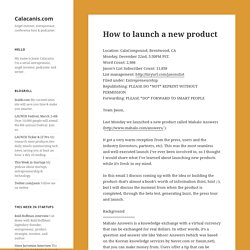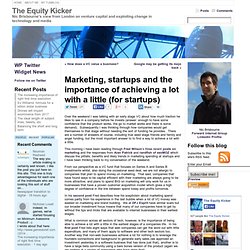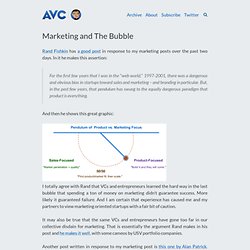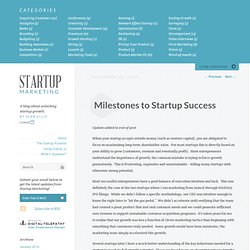

Dave McClure: quotable PG @YCombinator "... (88) Startups: How do you beat the network effect. » How to launch a new product Calacanis. Location: CalaCompound, Brentwood, CA Monday, December 22nd, 5:50PM PST.

Word Count: 2,986 Jason’s List Subscriber Count: 11,858 List management: Filed under: Entrepreneurship Republishing: PLEASE DO *NOT* REPRINT WITHOUT PERMISSION Forwarding: PLEASE *DO* FORWARD TO SMART PEOPLE Team Jason, Last Monday we launched a new product called Mahalo Answers ( ). It got a very warm reception from the press, users and the industry (investors, partners, etc).
This was the most seamless and well-executed launch I’ve ever been involved in, so I thought I would share what I’ve learned about launching new products while it’s fresh in my mind. In this email I discuss coming up with the idea or building the product–that’s almost a book’s worth of information (hint, hint ;-), but I will discuss the moment from when the product is completed, through the beta test, generating buzz, the press tour and launch. For context, this is the third of Mahalo’s five pillars. Now, on to the process. Simple. 1. 2. 3. 4. What's the best launch strategy for a web startup. (3) If I know that my site will go very viral no matter what, should I launch quietly or with a press blast. Marketing, startups and the importance of achieving a lot with a little (for startups) « The Equity Kicker. Over the weekend I was talking with an early stage VC about how much traction he likes to see in a company before he invests (answer: enough to have some confidence that the product works, the go to market works and there is some demand).

Subsequently I was thinking through how companies would get themselves to that stage without needing the sort of funding he provides. There are a number of answers of course, including true seed stage friends and family and angel funding, but the most important answer to to find a way to achieve a lot with a little. Marketing and The Bubble. Rand Fishkin has a good post in response to my marketing posts over the past two days.

In it he makes this assertion: For the first few years that I was in the "web world," 1997-2001, there was a dangerous and obvious bias in startups toward sales and marketing – and branding in particular. But, in the past few years, that pendulum has swung to the equally dangerous paradigm that product is everything. And then he shows this great graphic: I totally agree with Rand that VCs and entrepreneurs learned the hard way in the last bubble that spending a ton of money on marketing didn't guarantee success.
It may also be true that the same VCs and entrepreneurs have gone too far in our collective disdain for marketing. Another post written in response to my marketing post is this one by Alan Patrick. More shouting certainly isn't the kind of marketing I want to fund, and it is exactly the kind of marketing we all funded in the last bubble. The marketing challenge for startups. Watch this video with Indinero’s founder, Jessica Mah. She’s 20 years old. I’ve known her since she was 16 and she’s always been an aspiring entrepreneur. But look around the house that the co-founders all share. Five geeks sharing rent in Silicon Valley. Keeping expenses down. Milestones to Startup Success. Update added to end of post When your startup accepts outside money (such as venture capital), you are obligated to focus on maximizing long-term shareholder value.

For most startups this is directly based on your ability to grow (customers, revenue and eventually profit). Most entrepreneurs understand the importance of growth; the common mistake is trying to force growth prematurely. This is frustrating, expensive and unsustainable – killing many startups with otherwise strong potential. Most successful entrepreneurs have a good balance of execution intuition and luck. Several startups later I have a much better understanding of the key milestones needed for a startup to reach its full growth potential. Day 1: Validate Need for Minimum Viable Product (MVP) Before any coding begins it is important to validate that the problem/need you are trying to solve actually exists, is worth solving, and the proposed minimum feature set solves it.
The 5 Minute Guide To Cheap Startup Advertising. The following is a guest post by Rob Walling.

Rob Walling has been an entrepreneur for most of his life and is author of the book Start Small, Stay Small: A Developer's Guide to Launching a Startup. He also authors the top 20 startup blog Software By Rob, that's read by tens of thousands of startup entrepreneurs every month and he owns the leading ASP.NET invoicing software on the market in addition to a handful of profitable web properties. Imagine that you've just completed version 1 of your product and you're preparing for launch.